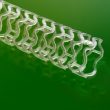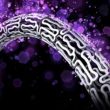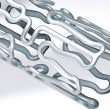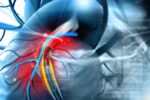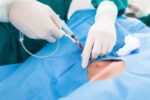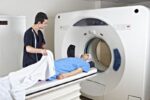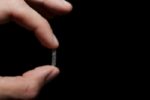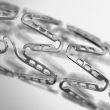Original Title: Clinical outcomes following “off-label” versus “established” indication of bioresorbable scaffolds for treatment of coronary artery disease in a real-world population. Reference: Tadashi Miyazaki, et al EuroIntervention 2016;11:475-478. Courtesy of Dr. Carlos Fava. Bioresorbable scaffolds (BSB) have shown their benefit in different studies, but there is little information available on “off label”...
Safety of High Pressure Post-dilation in Bioresorbable Scaffolds
Original Title: Is High Pressure Postdilation Safe in Bioresorbable Vascular Scaffolds? Optical Coherence Tomography Observations After Noncompliant Balloons Inflated at More than 24 Atmospheres. Reference: Enrico Fabris et al. Catheter Cardiovasc Interv. 2016 Apr;87(5):839-46. Courtesy of Dr. José Amadeo Guillermo Álvarez. The mechanical properties of bioresorbable vascular scaffolds (BVS) are different from those of bare...
Bioresorbable Scaffold Thrombosis: incidence, risk factors and possible mechanism
Original Title: Bioresorbable Vascular Scaffold Thrombosis. Multicenter Comprehensive Analysis of Clinical Presentation, Mechanisms, and Predictors. Reference: Puricel S et al. J Am Coll Cardiol 2016;67:921-31. Courtesy of Dr. Guillermo Migliaro. Bioresorbable scaffolds (BVS) were introduced in interventional cardiology to avoid late DES complications. However, recent reports suggest an elevated incidence of thrombosis with these new devices....
Definite/Probable Thrombosis with Bioresorbable Scaffolds
Original Title: Scaffold Thrombosis After Percutaneous Coronary Intervention With ABSORB Bioresorbable Vascular Scaffold. A Systematic Review and Meta-Analysis. Reference: Michael J. Lipinski et al. J Am Coll Cardiol Intv. 2016;9(1):12-24. The authors of this study carried out a systematic review and a meta-analysis to determine the thrombosis risk of the bioresorbable everolimus eluting scaffold ABSORB (Abbott...
ABSORB III: Everolimus Eluting Bioresorbable Scaffolds for Coronary Artery Disease
Original Title: Everolimus-Eluting Bioresorbable Scaffolds for Coronary Artery Disease. Reference: Stone, M.D. for the ABSORB III Investigators. N Engl J Med 2015;373:1905-1915. The ABSORB III is part of a series of randomized studies that test bioresorbable scaffolds in the clinical practice (ABSORB II, EVERBIO II, ABSORB Japan, and ABSORB IV). 2008 patients were randomized; 60% had...
Bioresorbable vascular scaffold vs. the best-in-class DES
Original title: Comparison of everolimus- and biolimus-eluting coronary stents with everolimus-eluting bioresorbable vascular scaffolds. Referencia: Puricel S. et al. J Am Coll Cardiol. 2015 Mar 3;65(8):791-801. The everolimus eluting bioresorbable scaffold (BVS) is effective at treating simple lesions in stable patients but it has yet to be assessed against the best-in-class DES. This study compared BVS performance against...
Thrombosis with bioresorbable scaffolds: the story of DES all over again?
Original title: Percutaneous coronary intervention with everolimus-eluting bioresorbable vascular scaffolds in routine clinical practice: early and midterm outcomes from the European multicentre GHOST-EU registry. Reference: Capodanno D et al. EuroIntervention. 2014 Jul 18. Epub ahead of print The GHOST-EU registry, that included 1189 patients from 10 European centers between 2011 and 2014, is now the largest registry...
Multislice computed tomography for bioresorbable scaffolds: the end of invasive diagnostic studies?
Original title: Multislice Computed Tomography Angiography for Non-invasive Assessment of the 18-Months Performance of a Novel Radiolucent Bioresorbable Vascular Scaffolding Device (ABSORB Trial). Reference: Koen Nieman et al. J Am Coll Cardiol, article in press. Metal stents revolutionized coronary angioplasty procedures; however, they are permanent prosthetic devices that make re intervention difficult and prolongue thrombosis risk. This problem...
Bioresorbable stents produce more occlusion of the small side branches
Original title: Incidence and Short-Term Clinical Outcomes of Small Side Branch Occlusion Alter Implantation of an Everolimus-Eluting Bioresorbable Vascular Scaffold Reference: Takashi Muramatsu et al. J Am Coll Cardiol Intv 2013;6:247–57. Small Side Branch Occlusion (SBO) during coronary angioplasty has been associated with periprocedural infarction. Among the factors that cause SBO are carina displacement, plaque displacement and artery...
BVS: Controvertial Scaffold
Courtesy of Dr. Agustín Vecchia. The advent of resorbable vascular scaffolds (BVS) generated high expectations among interventionists because of its potential advantages over bare metal stents. However, when comparing BVS against the Xience stent, we observed an increased rate of events associated to the first device, to their detriment. Among the reasons behind this poor...

